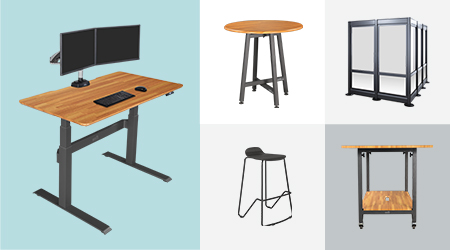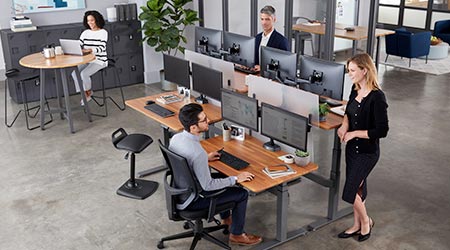SPONSORED
Varidesk - Branded Feature
Why Flexible, Open Office Furniture is Vital for Quickly Growing Companies
For high-growth companies, an open, flexible work environment is both an essential and universal asset that equally impacts the operational, financial, and cultural aspects of the business. An office outfitted with adaptable workstations provides proven benefits for productive employees; however, poorly-planned open office concepts have been criticized by employees and scholars alike.
For employees, issues with a simple, open-office floor plan often arise — complaints about noisy neighbors, a lack of privacy, or the numerous interruptions that happen in unmanaged open work plans. If left unchecked, the open workplace can be a real pain. So, if these types of workspaces are that bad, why are they becoming more popular?
Primarily, the economics don’t lie — open offices are less expensive to set up. In fact, JLL reports that a “tech office,” which has open ceilings, flexible workspaces, and concrete floors, is about 15% less expensive than a traditional office space. A high-growth company can benefit by saving money on flexible office furniture and reinvest those savings into initiatives that matter like salaries or recruiting costs.
Second, businesses can maximize their density as needed by comfortably fitting more employees in the same space. This is important for high-growth companies that suffer from a lack of space due to the long-term lease they signed when they were smaller. Flexible office furniture that adapts as the business needs change can save time, effort and cost by functionally scaling with the growth of the company.
Third, the ability to flex and change a workspace quickly allows growing companies to adapt to changing workspace needs. Whether department structures change, more collaboration is needed or private offices become more important, adaptable furniture solutions allow for agile businesses to thrive.
Finally, when done right, open offices can enable an open, collaborative culture. At high-growth companies, the importance of culture is well researched, and one only needs to step onto the floor of a buzzing and energetic office to understand the intrinsic value that the open workspace provides.
While the economics of an open space are attractive, many companies don’t put the time and energy into truly understanding how to make it work for their business. From your space plan to the furniture you specify, there are many opportunities to influence your workspace. This is where a partner such as VARIDESK® who focuses on the needs of high-growth companies is an advantage. With a history of helping create healthier workspaces, VARIDESK has also become known for helping companies implement the open work plan in a way that enhances culture and productivity. What are some of the strategies to accomplish this outcome?

Appeal
You have to create a workspace that employees want to work in. In the battle to recruit great talent and retain your top performers, the workspace has become an important advantage to which many employers haven’t paid enough attention. According to a recent Wellness Together study, 48% of participants indicated that workplace design has a notable impact on their decision of whether to stay with an employer. Keeping the space flexible and incorporating active elements like standing desk solutions from VARIDESK can help employees stay motivated and engaged for the long term.
Flexibility
You can work for months on an open space plan that solves for your business needs today. Unfortunately, those plans usually fail to take into account every possible variable, and issues with the flow and layout of the workspace become glaringly obvious once you begin to work in them. High-growth clients will likely need to reconfigure the space after a few months to work out the kinks in the initial design and account for new changes in headcount. VARIDESK products such as rolling conference tables and movable walls allow you to change your design without costly downtime or distractions.
Workstation Diversity
Any workspace strategist will tell you that an individual’s work styles and needs differ in the workplace, sometimes in the same hour. High-growth companies are recognizing this and trying different ways to satisfy these changes in requirement. The answer is to offer different types of spaces for different types of work, but that often means specifying a wide range of furniture from multiple sources. VARIDESK, however, offers complimentary space planning services that will understand how the individual teams within a space will work (i.e. focus work, collaborative, etc.), and design around those styles. Plus, their breadth of products mean you have a single source for your needs.
Privacy
Many of the concerns of an open office center around privacy and interruptions which can have an impact on a company’s overall culture. With workstations out in the open, usually in full view of many on the team, it’s natural that team members will feel uncomfortable with their work being on display. Simple things like screen filters and privacy panels can help create privacy in the open. This is also where creating alternative collaboration spaces become vital. Using VARIDESK solutions to create private workspaces like work pods – small rooms with a single desk and monitors that can be booked like a conference room – are perfect respites for individual focus work.
VARIDESK even offers phone booths for private calls or video conferences.
While the open office as it’s known today may not be considered the best solution for all companies, with minor tweaks and the right partnership, the open space can not only help the financial health of the business but also enhance productivity and engagement for its hardworking employees.
Being deliberate about the space, managing expectations around its purpose and making a point to reconfigure and change your workspace often will help your company culture thrive and your business grow.










